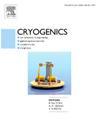低温逆流板翅式换热器设计优化研究
IF 1.8
3区 工程技术
Q3 PHYSICS, APPLIED
引用次数: 0
摘要
板翅式换热器是非常紧凑,高效(> 95%),可以处理多流低压降。因此,这些热交换器主要用于现代大容量氦气液化器/制冷机循环。低温系统,如氦液化器和冰箱是能源密集型系统,在室温下消耗大量电力。人们一直在寻求提高这些系统的热力学性能和减少冷却时间。热交换器覆盖了这些低温系统的大部分体积和质量。在质量和体积方面的高效和优化设计对提高这些系统的效率和冷却时间起着重要作用。本研究的目的是在相同的热工性能下,找到使这些热交换器的质量和体积最小的设计配置。本文以300 - 90k温度范围热交换器为例进行了研究。目前的研究表明,通过选择适当的鳍几何形状,可以减少44.5%的质量。本文章由计算机程序翻译,如有差异,请以英文原文为准。
Design optimization study of cryogenic counter-flow plate fin heat exchangers
Plate-fin heat exchangers are very compact, efficient (>95 %) and can handle multiple streams with low pressure drops. Therefore, these heat exchangers are essentially used in modern large capacity helium liquefier/refrigerator cycles. Cryogenic systems such as helium liquefiers and refrigerators are energy intensive systems and consume large power at room temperature. There is always quest for improved thermodynamic performance and reduction in cool-down time of these systems. Heat exchangers cover major volume and mass in these cryogenic systems. Efficient and optimized design in terms of mass and volume play major role in efficiency improvement and cool-down time of these systems. Present study is aimed to arrive on design configurations which lead to minimum mass and volume of these heat exchangers for the same thermo-hydraulic performance. Method developed here is applied on a heat exchanger which operates in 300–90 K temperature range as a case study. Present study indicates that 44.5 % mass reduction is possible by choosing appropriate fin geometries.
求助全文
通过发布文献求助,成功后即可免费获取论文全文。
去求助
来源期刊

Cryogenics
物理-热力学
CiteScore
3.80
自引率
9.50%
发文量
0
审稿时长
2.1 months
期刊介绍:
Cryogenics is the world''s leading journal focusing on all aspects of cryoengineering and cryogenics. Papers published in Cryogenics cover a wide variety of subjects in low temperature engineering and research. Among the areas covered are:
- Applications of superconductivity: magnets, electronics, devices
- Superconductors and their properties
- Properties of materials: metals, alloys, composites, polymers, insulations
- New applications of cryogenic technology to processes, devices, machinery
- Refrigeration and liquefaction technology
- Thermodynamics
- Fluid properties and fluid mechanics
- Heat transfer
- Thermometry and measurement science
- Cryogenics in medicine
- Cryoelectronics
 求助内容:
求助内容: 应助结果提醒方式:
应助结果提醒方式:


